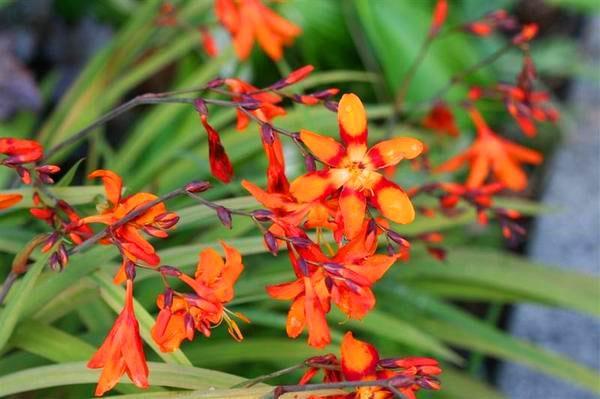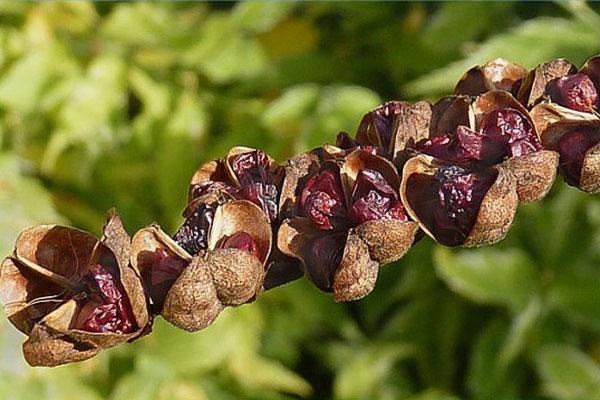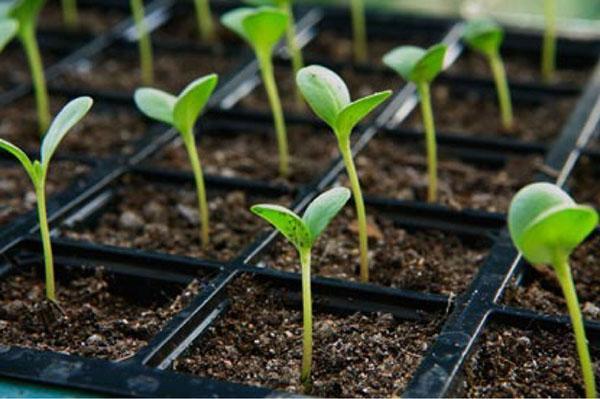Growing crocosmia outdoors is easy and simple
 Crocosmia or montbrecia is a perennial native to Africa, belonging to the Iris family. Despite the fact that crocosmia is a capricious plant, planting and care in the open field is possible in our latitudes. The main thing is to know a few secrets for growing this African guest.
Crocosmia or montbrecia is a perennial native to Africa, belonging to the Iris family. Despite the fact that crocosmia is a capricious plant, planting and care in the open field is possible in our latitudes. The main thing is to know a few secrets for growing this African guest.
There are two ways to grow crocosmia - seeds and corms. It is undesirable to plant seeds directly into the ground, since they are very likely to simply not germinate. But the corms are more resistant to temperature extremes and pests, so they can be safely placed directly into the soil.
How to grow crocosmia from seeds

 After sowing, containers with future seedlings must be covered with foil and placed in a sunny place (and artificial lighting). As soon as 2-3 leaves appear on the sprouts, you can plant individual plants in more spacious pots. Before planting and caring for crocosmia outdoors in Siberia, where the climate is too harsh, take the flower pots out into the fresh air. Increase the amount of time the plant spends outside each day to adapt to changing weather conditions.
After sowing, containers with future seedlings must be covered with foil and placed in a sunny place (and artificial lighting). As soon as 2-3 leaves appear on the sprouts, you can plant individual plants in more spacious pots. Before planting and caring for crocosmia outdoors in Siberia, where the climate is too harsh, take the flower pots out into the fresh air. Increase the amount of time the plant spends outside each day to adapt to changing weather conditions.
Planting and caring for crocosmia in the open field
 Crocosmia is best planted in well-lit areas; in the shade, you will get elongated pale plants. It is advisable that the flowerbed is on an elevation - so the corms will not flood after the rains. Strong drafts can also damage flowers.
Crocosmia is best planted in well-lit areas; in the shade, you will get elongated pale plants. It is advisable that the flowerbed is on an elevation - so the corms will not flood after the rains. Strong drafts can also damage flowers.
The time for planting crocosmia in open ground is mid-May, when the threat of late frosts disappears. In temperate climates, flowers can be planted by the end of April.
A place for planting should be chosen in advance so that in the fall to loosen the soil and add sand (so that the water does not stagnate in the roots after irrigation) and mineral fertilizers.
Before planting, it is necessary to water well and loosen the soil in the flowerbed. Corms ready for planting should be planted so that a distance of at least 10 centimeters remains between adult plants. Planting depth is about 8 cm.
Planting crocosmia and caring for it in the open ground in the Urals is possible only if the garden bed can be covered during the cold weather. Growing in sunlit glazed greenhouses will give a good result.
To avoid cross-pollination, it is better to plant crocosmia of different varieties in different beds, with sufficient distance from each other.
Proper care of young crocosmia
 The most important thing for crocosmia is timely watering... Perennials need to be watered every week, but it is worth monitoring the weather so that the bulbs do not rot on rainy days. In hot weather, the abundance of watering should increase.
The most important thing for crocosmia is timely watering... Perennials need to be watered every week, but it is worth monitoring the weather so that the bulbs do not rot on rainy days. In hot weather, the abundance of watering should increase.
Before the first inflorescences appear, as soon as the leaves develop, it is necessary to make the first feeding.A solution of mullein, mineral mixtures with potassium and special formulations for bulbous plants are suitable as fertilizers.
You don't need to tie crocosmia - it keeps its shape on its own, so you don't have to worry about the safety of the peduncles.
Post-flowering care
 As soon as the crocosmia blooms, it is advisable to cut off the peduncles - this way more plant energy will be spent on preserving the corms.
As soon as the crocosmia blooms, it is advisable to cut off the peduncles - this way more plant energy will be spent on preserving the corms.
If a cold winter is expected, the bulbs are dug up in the fall, carefully peeled from the ground and stored in a cool room. However, if it is possible to do without digging, it is better to leave the corms in the ground. So the flowers will better develop the root system and will delight you with lush flowering next year.
Small-flowered species of montbrecia tolerate wintering without digging out of open ground, but it is better to play it safe by covering the flower bed with a 20-centimeter layer of sawdust and leaves.
 Let's summarize:
Let's summarize:
- Preparation for planting and caring for crocosmia in the open field begins in the fall - a suitable place is chosen, the soil is loosened and fertilized.
- Plants grow well in sunny heights, in soil rich in humus and peat.
- Sowing with seeds directly into open ground for crocosmia is undesirable, it is best to prepare seedlings in advance.
- The easiest crocosmia care is weekly watering.
- Before wintering, the ground part of the plant is cut off, and the ground above the corms is covered with a layer of sawdust and leaves. Any other organic coating will do.